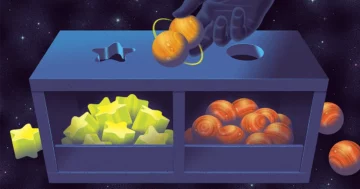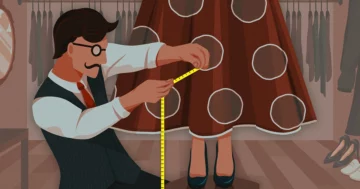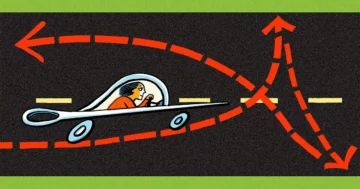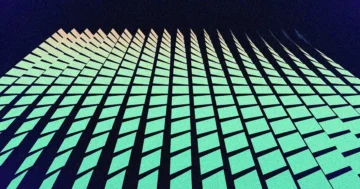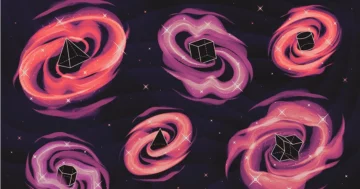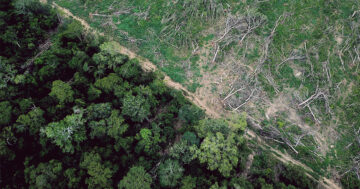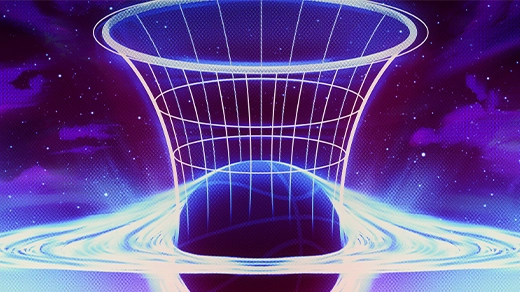
Introduction
The modern notion of a black hole has been with us since February 1916, three months after Albert Einstein unveiled his theory of gravity. That’s when the physicist Karl Schwarzschild, in the midst of fighting in the German army during World War I, published a paper with astonishing implications: If enough mass is confined within a perfectly spherical region (bounded by the “Schwarzschild radius”), nothing can escape such an object’s intense gravitational pull, not even light itself. At the center of this sphere lies a singularity where density approaches infinity and known physics goes off the rails.
In the 100-plus years since, physicists and mathematicians have explored the properties of these enigmatic objects from the perspective of both theory and experiment. So it may be surprising to hear that “if you took a region of space with a bunch of matter spread out in it and asked a physicist if that region would collapse to form a black hole, we don’t yet have the tools to answer that question,” said Marcus Khuri, a mathematician at Stony Brook University.
Don’t despair. Khuri and three colleagues — Sven Hirsch at the Institute for Advanced Study, Demetre Kazaras at Duke University, and Yiyue Zhang at the University of California, Irvine — have released a new paper that brings us closer to determining the presence of black holes based solely on the concentration of matter. In addition, their paper proves mathematically that higher-dimensional black holes — those of four, five, six or seven spatial dimensions — can exist, which is not something that could confidently have been said before.
To put the recent paper in context, it might be worth backing up to 1964, the year Roger Penrose began introducing the singularity theorems that earned him a share of the 2020 Nobel Prize in Physics. Penrose proved that if space-time has something called a closed trapped surface — a surface whose curvature is so extreme that outward-going light gets wrapped around and turned inward — then it must also contain a singularity.
It was a monumental result, in part because Penrose brought powerful new tools from geometry and topology to the study of black holes and other phenomena in Einstein’s theory. But Penrose’s work did not spell out what it takes to create a closed trapped surface in the first place.
In 1972, the physicist Kip Thorne took a step in that direction by formulating the hoop conjecture. Thorne recognized that figuring out whether a nonspherical object — one lacking the symmetry assumed in Schwarzschild’s pioneering efforts — would collapse into a black hole would be “much harder to compute [and] indeed far beyond my talents.” (Thorne would go on to win the 2017 Nobel Prize in Physics.) Yet he felt his conjecture might make the problem more manageable. The basic idea is to first determine the mass of a given object and from that compute the critical radius of a hoop that the object must fit within — no matter how the hoop is oriented — to make the formation of a black hole inevitable. It would be like showing that a hula hoop that fits around your waist could also — if rotated 360 degrees — fit around your entire elongated body, including your feet and head. If the object fits, it will collapse to a black hole.
“The hoop conjecture is not well defined,” Kazaras commented. “Thorne intentionally used vague wording in the hopes that others would provide a more precise statement.”
In 1983, the mathematicians Richard Schoen and Shing-Tung Yau obliged, proving an important version of the hoop conjecture, subsequently referred to as the black hole existence theorem. Schoen and Yau showed — in a clear-cut mathematical argument — just how much matter must be crammed into a given volume to induce the space-time curvature necessary to create a closed trapped surface.
Kazaras praised the Schoen-Yau work for its originality and generality; their technique could reveal whether any configuration of matter, regardless of symmetry considerations, was destined to become a black hole. But their approach had a major drawback. The way they measured the size of a given region of space — by determining the radius of the fattest torus, or doughnut, that could fit inside — was, to many observers, “cumbersome and nonintuitive,” Kazaras said, and hence impractical.
The recent paper offers an alternative. One of Schoen and Yau’s major innovations was to recognize that an equation devised by the physicist Pong Soo Jang, which originally had nothing to do with black holes, can “blow up” — go to infinity — at certain points in space. Amazingly, where it blows up coincides with the location of a closed trapped surface. So if you want to find such a surface, first figure out where the Jang equation goes to infinity. “In high school, we often try to solve an equation when the solution is equal to zero,” explained the mathematician Mu-Tao Wang of Columbia University. “In this case, we’re trying to solve the [Jang] equation such that the solution is infinite.”
Hirsch, Kazaras, Khuri and Zhang also rely on the Jang equation. But in addition to a torus, they use a cube — one that can be seriously deformed. This approach “is akin to Thorne’s idea, using square hoops instead of traditional circular hoops,” Khuri said. It draws upon the “cube inequality” developed by the mathematician Mikhail Gromov. This relationship connects the size of a cube to the curvature of space in and around it.
The new paper shows that if you can find a cube somewhere in space such that the matter concentration is large compared to the size of the cube, then a trapped surface will form. “This measurement is much easier to check” than one involving a torus, said Pengzi Miao, a mathematician at the University of Miami, “because all you need to compute is the distance between the cube’s two nearest opposing faces.”
Mathematicians can also build doughnuts (tori) and cubes in higher dimensions. In order to extend their proof of black hole existence to these spaces, Hirsch and colleagues built upon geometric insights that have been developed in the four decades since Schoen and Yau’s 1983 paper. The team was unable to go beyond seven spatial dimensions because singularities start cropping up in their results. “Getting around those singularities is a common sticking point in geometry,” Khuri said.
The logical next step, he said, is to prove black hole existence based on “quasi-local mass,” which includes the energy coming from both matter and gravitational radiation, rather than from matter alone. That’s no simple task, in part because there is no universally agreed-upon definition of quasi-local mass.
Meanwhile, another question looms: To create a black hole of three spatial dimensions, must an object be compressed in all three directions, as Thorne insisted, or could compression in two directions or even just one be enough? All evidence points to Thorne’s statement being true, Khuri said, though it is not yet proved. Indeed, it is just one of many open questions that persist about black holes after they first manifested more than a century ago in a German soldier’s notebook.
- SEO Powered Content & PR Distribution. Get Amplified Today.
- PlatoData.Network Vertical Generative Ai. Empower Yourself. Access Here.
- PlatoAiStream. Web3 Intelligence. Knowledge Amplified. Access Here.
- PlatoESG. Automotive / EVs, Carbon, CleanTech, Energy, Environment, Solar, Waste Management. Access Here.
- PlatoHealth. Biotech and Clinical Trials Intelligence. Access Here.
- ChartPrime. Elevate your Trading Game with ChartPrime. Access Here.
- BlockOffsets. Modernizing Environmental Offset Ownership. Access Here.
- Source: https://www.quantamagazine.org/math-proof-draws-new-boundaries-around-black-hole-formation-20230816/
- :has
- :is
- :not
- :where
- ][p
- $UP
- a
- About
- addition
- advanced
- After
- ago
- All
- alone
- also
- alternative
- an
- and
- Another
- answer
- any
- approach
- approaches
- argument
- Army
- around
- AS
- asked
- assumed
- At
- backing
- based
- basic
- BE
- because
- become
- been
- before
- began
- being
- between
- Beyond
- Black
- Black Hole
- black holes
- body
- both
- boundaries
- Brings
- brought
- build
- built
- Bunch
- but
- by
- california
- called
- CAN
- case
- Center
- Century
- certain
- closed
- closer
- Collapse
- colleagues
- Columbia
- coming
- commented
- Common
- compared
- Compute
- concentration
- confidently
- Configuration
- conjecture
- connects
- considerations
- context
- could
- create
- critical
- decades
- defined
- definition
- density
- destined
- Determine
- determining
- developed
- DID
- dimensions
- direction
- distance
- do
- Dont
- draws
- Duke
- duke university
- during
- earned
- easier
- efforts
- einstein
- energy
- enough
- Entire
- equal
- escape
- Even
- evidence
- exist
- existence
- experiment
- explained
- Explored
- extend
- extreme
- faces
- far
- February
- Feet
- fighting
- Figure
- Find
- First
- fit
- five
- For
- form
- formation
- formulating
- four
- from
- geometry
- German
- given
- Go
- Goes
- gravitational
- gravity
- had
- harder
- Have
- he
- head
- hear
- hence
- High
- higher
- him
- his
- Hole
- Holes
- hopes
- How
- HTML
- HTTPS
- i
- idea
- if
- implications
- important
- in
- includes
- Including
- indeed
- inevitable
- Infinity
- innovations
- inside
- insights
- instead
- Institute
- intentionally
- into
- introducing
- involving
- IT
- ITS
- itself
- just
- just one
- karl
- known
- large
- lies
- light
- like
- location
- logical
- magazine
- major
- make
- manageable
- many
- Mass
- math
- mathematical
- mathematically
- Matter
- May..
- measured
- measurement
- Miami
- might
- mikhail
- Modern
- months
- monumental
- more
- much
- must
- my
- necessary
- Need
- New
- next
- no
- nobel
- nobel prize
- notebook
- nothing
- Notion
- object
- objects
- obliged
- of
- off
- Offers
- often
- on
- ONE
- open
- or
- order
- originality
- originally
- Other
- Others
- out
- Paper
- part
- perfectly
- perspective
- Physics
- Pioneering
- Place
- plato
- Plato Data Intelligence
- PlatoData
- Point
- points
- Pong
- powerful
- Praised
- precise
- presence
- prize
- Problem
- proof
- properties
- Prove
- proved
- proves
- provide
- published
- put
- Quantamagazine
- question
- Questions
- Radiation
- rails
- rather
- recent
- recognize
- recognized
- referred
- Regardless
- region
- relationship
- released
- rely
- result
- Results
- reveal
- Richard
- Said
- School
- seriously
- seven
- Share
- showed
- showing
- Shows
- Simple
- since
- singularity
- SIX
- Size
- So
- solely
- solution
- SOLVE
- something
- somewhere
- Space
- spaces
- Spatial
- SPELL
- spread
- square
- start
- Statement
- Step
- sticking
- Study
- Subsequently
- such
- Surface
- surprising
- takes
- talents
- Task
- team
- than
- that
- The
- their
- then
- theory
- There.
- These
- they
- this
- those
- though?
- three
- to
- took
- tools
- traditional
- true
- try
- Turned
- two
- unable
- universally
- university
- University of California
- unveiled
- upon
- us
- use
- used
- using
- version
- volume
- want
- war
- was
- Way..
- we
- webp
- WELL
- What
- when
- whether
- which
- whose
- will
- win
- with
- within
- wording
- Work
- world
- worth
- would
- Wrapped
- year
- years
- yet
- you
- Your
- zephyrnet
- zero


